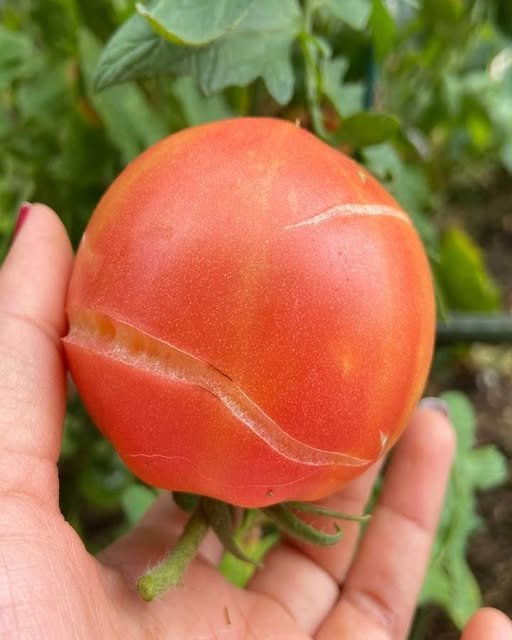Tomatoes are a beloved staple in gardens around the world, celebrated for their versatility and flavor. However, many gardeners face the frustrating issue of tomato splitting, where the fruit develops unsightly cracks. This not only affects the aesthetic appeal of the tomatoes but can also lead to spoilage and reduced yields. Understanding why tomatoes split and how to prevent it is crucial for any gardener looking to maximize their harvest.
Understanding the Problem: What is Tomato Splitting?
Tomato splitting occurs when the skin of the tomato cracks open, usually in a circular pattern around the stem or vertically along the sides. This phenomenon is primarily due to fluctuations in water uptake, which causes the inner fruit to expand faster than the skin can stretch. As a result, the skin splits to accommodate the sudden growth. While split tomatoes are still edible, they are more susceptible to pests and rot.
Top Reasons Why Tomatoes Split
Several factors contribute to the splitting of tomatoes, each related to the plant’s growth environment and care practices. Understanding these reasons can help gardeners take proactive measures to prevent splitting and ensure a healthy crop.
Reason 1: Inconsistent Watering Practices
One of the most common causes of tomato splitting is inconsistent watering. When tomatoes experience a dry spell followed by heavy watering, the sudden influx of water causes the fruit to swell rapidly. This rapid expansion can lead to the skin splitting, as it cannot stretch quickly enough to accommodate the increased size.
Reason 2: Rapid Growth Spurts
Tomatoes can experience rapid growth spurts during periods of favorable weather conditions, such as warm temperatures and ample sunlight. During these spurts, the fruit may grow faster than the skin can expand, leading to splitting. This is particularly common in young tomatoes that are still developing.
Reason 3: Excessive Rainfall
Heavy rainfall can saturate the soil and lead to excessive water uptake by the tomato plants. This sudden increase in water availability can cause the fruit to swell quickly, resulting in splits. Rainfall is a natural factor that is difficult to control, making it a common cause of tomato splitting in regions with unpredictable weather.
Reason 4: Over-Fertilization
Applying too much fertilizer, particularly those high in nitrogen, can promote rapid growth in tomato plants. While growth is generally desirable, excessive growth can lead to splitting as the fruit expands too quickly for the skin to keep up. Balanced fertilization is key to preventing this issue.
Reason 5: Varietal Susceptibility
Some tomato varieties are more prone to splitting than others due to their genetic makeup. Heirloom varieties, for example, often have thinner skins and are more susceptible to cracking. Choosing the right variety for your growing conditions can help minimize the risk of splitting.
How to Prevent Tomato Splitting
Preventing tomato splitting involves a combination of proper watering techniques, soil management, and careful selection of tomato varieties. By implementing these strategies, gardeners can reduce the incidence of splitting and enjoy a bountiful harvest.
Tip 1: Maintain Consistent Watering
To prevent splitting, it’s crucial to maintain a consistent watering schedule. Water your tomatoes deeply and regularly, aiming for about 1-2 inches of water per week. This helps to keep the soil evenly moist and reduces the risk of sudden water uptake.
Tip 2: Use Mulch to Retain Soil Moisture
Applying a layer of mulch around your tomato plants can help retain soil moisture and regulate temperature. Mulch acts as a barrier, reducing evaporation and keeping the soil consistently moist, which is essential for preventing splitting.
Tip 3: Select Resistant Varieties
Choosing tomato varieties that are less prone to splitting can significantly reduce the incidence of this problem. Look for hybrid varieties that are bred for thicker skins and resistance to cracking, especially if you live in an area with variable weather conditions.
Tip 4: Monitor and Adjust Fertilizer Use
Use a balanced fertilizer and avoid over-fertilizing your tomato plants. Too much nitrogen can lead to rapid growth and splitting. Instead, opt for a fertilizer with a balanced ratio of nitrogen, phosphorus, and potassium to promote steady growth.
Tip 5: Provide Adequate Support for Plants
Supporting your tomato plants with cages or stakes can help prevent splitting by keeping the fruit off the ground and reducing stress on the plant. Proper support ensures that the fruit develops evenly and is less likely to split due to uneven weight distribution.
Conclusion: Keeping Your Tomatoes Intact
Tomato splitting can be a frustrating issue for gardeners, but with the right knowledge and practices, it can be effectively managed. By understanding the causes of splitting and implementing preventative measures, you can enjoy a healthy, abundant tomato harvest. Consistent care and attention to your plants’ needs will go a long way in keeping your tomatoes intact and thriving.



